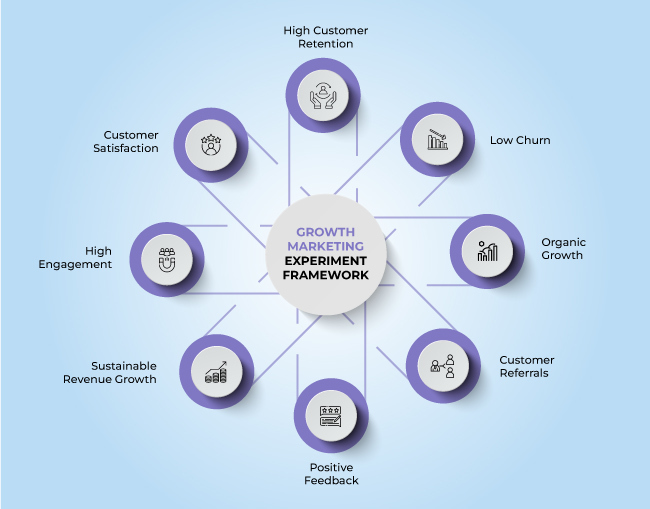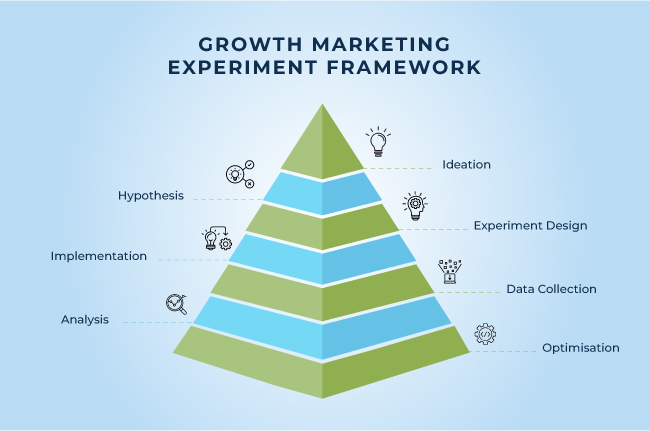Introduction
Product-market fit has long been the Holy Grail for businesses, but in a rapidly changing environment, it's essential not just to find it but also to future-proof it. The pursuit of product-market fit is the elusive sweet spot where your offering seamlessly aligns with your target audience's needs and desires. Yet, achieving and maintaining this equil ibrium requires a dynamic approach that keeps pace with changing market dynamics. This is where growth marketing experiments come into play. They enable businesses to continually adapt, ensuring that their product remains in perfect harmony with their audience's evolving demands.
In this blog post, we'll delve into the world of growth marketing experiments and how they can future-proof your product marketing strategy.
What is Product-Market Fit?


Product-market fit is the alignment between your product or service and your target market. It's the point where your offering solves a genuine problem and provides a unique value proposition that sets you apart from competitors. However, in today's highly competitive market, more than simply achieving product-market fit is required.
To impress customers and keep them coming back, you need more than just a great product; you need a great customer experience. According to the Zendesk Customer Experience Trends Report, 73% of customers will abandon a brand after multiple negative experiences. The takeaway here is that your product should not only meet your market's needs but should do so with an exceptional customer experience.
This is where future-proofing becomes crucial. The business world is in constant flux. Consumer preferences shift, technologies evolve, and new players enter the market. To stay ahead, you must ensure that your product-market fit remains robust and adaptable, capable of enduring the test of time and competition.
Signals of Product-Market Fit

Now, let's explore how growth marketing experiments can help you achieve and maintain these signals.
The Role of Growth Marketing Experiments
Growth marketing is all about experimenting and optimising to drive business growth. It's an iterative process that involves testing various strategies, measuring their impact, and fine-tuning your approach to find what works best for your product.
Growth marketing experiments serve as the heart of this process. These experiments are structured tests designed to discover new insights and uncover effective strategies. They are conducted with a clear hypothesis and a measurement plan. The growth marketing experiment framework typically involves these key steps:

-
Ideation: This initial phase involves brainstorming and identifying potential experiments to solidify the product-market fit. It's the stage where various ideas are explored to test how a product resonates with the market..
-
Hypothesis: Here, a distinct hypothesis is formulated for the experiment, explicitly tailored to ascertain or enhance the alignment between the product and the target market. The hypothesis defines the anticipated outcome regarding the product's market suitability.
-
Experiment Design: This phase concentrates on planning the execution of experiments to ascertain or enhance product-market fit. Specific metrics are set to measure the success of aligning the product with the needs and preferences of the intended market.
-
Implementation: Execution of the experiment is carried out according to the defined plan and strategies specifically focused on product-market fit. The aim is to observe the product's acceptance and relevance within the target market.
-
Data Collection: During this stage, data and metrics are systematically gathered. Various indicators and insights are collected to assess the degree of alignment between the product and the market's demands.
-
Analysis: Post-execution, the accumulated data is meticulously analysed to ascertain the experiment's impact. It aims to assess the level of acceptance and resonance of the product within the identified market.
-
Optimisation: Based on the analysis and results, adjustments are made to refine the approach. The optimisation stage focuses on improving the product's alignment with the market, utilising the insights gained from the experiment's outcomes.
Strategies to Implement Effective Growth Marketing Campaigns
-
A/B Testing: This strategy involves comparing two variations of a webpage, email, or ad to determine which version resonates better with the target audience. It is a valuable tool in refining strategies specifically geared towards achieving product-market fit.
-
Content Marketing: Create engaging, valuable content strategically tailored to align with the needs and interests of the intended audience. The aim is to attract and retain customers by offering content that directly contributes to achieving the product-market fit.
-
Customer Analysis: Leverage customer data and insights to comprehend customer behaviours and preferences. This strategy assists in tailoring marketing endeavours to specifically attain the product-market fit by understanding and addressing customer needs.
-
Hyper-Personalisation: Utilise granular data and advanced technology to personalise marketing efforts on an individual customer level. This strategy aims to intricately tailor marketing strategies and content, aligning with each customer's specific requirements.
-
Re-Engagement Campaigns: These campaigns are designed to reconnect with customers who previously interacted with a brand but have since become disengaged or inactive. The objective is to re-establish the alignment between the product and the market.
-
Influencer Marketing: Collaborate with influencers who possess a substantial following and influence in a specific niche or industry. Through this strategy, align the product with the intended market by leveraging influencers' credibility and impact within the domain.
-
Partnerships and Alliances: Partnerships involve collaborating with other businesses or organizations to create mutually beneficial relationships. These alliances can take various forms, depending on your industry and goals. As a result, you get access to a wider audience, leverage trust and credibility with partners, diversify product offerings, and more.
-
Referrals: Referral marketing involves encouraging existing customers to refer new customers to your product or service. This may include offering rewards to customers who refer others, such as discounts, cash incentives, or exclusive access to features. Make sure the incentive is appealing enough to motivate action.
Benefits of Growth Marketing Strategies


During the acquisition stage, the objective is to identify suitable leads and transform them into customers. The primary goal involves raising awareness and then converting that awareness into action, specifically leading to a purchase decision.
This phase is pivotal, as it's where the user opts to engage with your company by registering for a product demonstration or a complimentary trial. Your growth marketing team's concentration should be on establishing robust customer acquisition channels. Several viable options for this stage encompass:
-
Continuous Improvement: Growth marketing experiments allow you to adapt to changing market conditions and consumer preferences, ensuring your product remains relevant.
-
Cost Efficiency: These strategies help you allocate resources more efficiently, focusing on tactics that yield the best results.
-
Data-Driven Decisions: Data from experiments provides valuable insights, allowing you to make informed decisions and prioritise strategies.
-
Faster Growth: Optimization through growth marketing accelerates your growth, helping you reach and retain more customers.
Proven Examples
Let's look at some real-life examples of companies that successfully used growth marketing to solidify their product-market fit.
Airbnb: Airbnb employed data-driven growth marketing experiments to fine-tune its product and drive exponential growth. By optimising its user experience and enhancing property listings, Airbnb managed to create a strong product-market fit and become a market leader in the hospitality industry.
Dropbox: Dropbox utilised referral marketing as a growth strategy. By incentivising users to refer friends, Dropbox achieved significant customer growth, further strengthening its product-market fit.
The Way Forward
To future-proof your product-market fit and make the most of growth marketing, you need a partner who understands the intricate world of digital marketing. That's where we come into play. At Amura, a leading Growth Marketing Agency, we offer tailored strategies and solutions to help your business thrive. We specialise in various areas, including content marketing, customer analysis, social media marketing, PPC advertising, SEO, SEM, and many more, ensuring that your growth marketing campaigns are effective and future-proof.
Over the last 15 years, we have helped companies like Glenmark, Cummins, Kenstar, iVOOMi, and Castrol adopt growth marketing strategies. So, if you're looking to secure your place in the ever-competitive landscape and stay ahead of the curve, consider incorporating growth marketing into your product marketing strategy. With the right approach and partners like Amura Marketing Technologies, you can navigate the complexities of the market and emerge as a formidable player.







